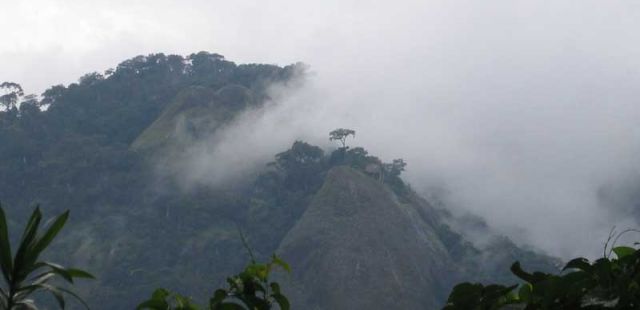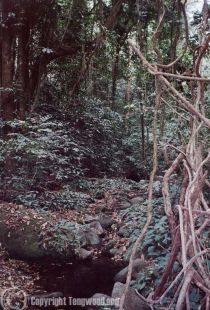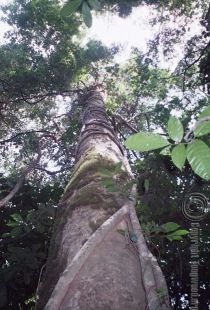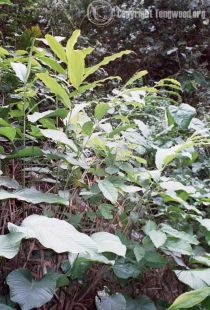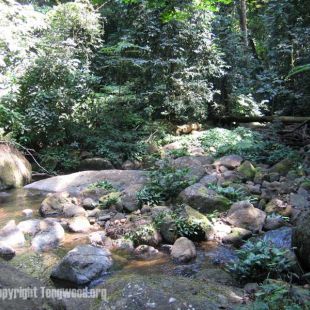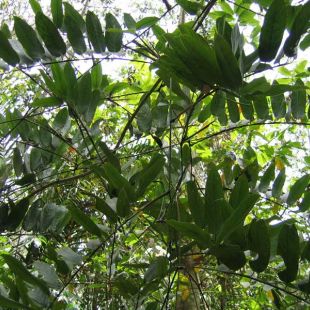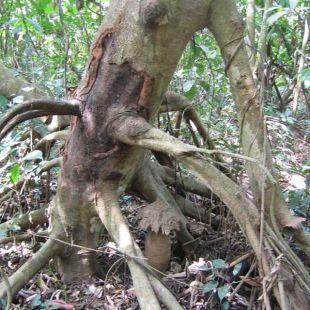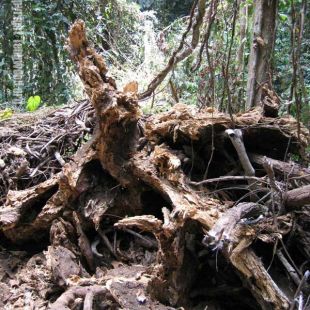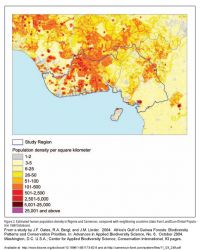The Forest
The forest region where the drill and the ellioti chimpanzee subspecies live has never been well defined. It is considered part of the Gulf of Guinea forests, which stretch from Sierra Leone in West Africa to the Congo Basin in Central Africa. In relation to the rest of Africa, the Gulf of Guinea forests are a biodiversity 'hotspot', meaning that they are high in species richness (biodiversity) as well as high in endemic species.
The Gulf of Guinea Forests
The Gulf of Guinea forests can be separated into two distinct regions; the Upper Guinea forests, from Sierra Leone to Togo (shown on this map in red) and the Lower Guinea forests of Nigeria and Cameroon (shown on the map here in green). These two forest blocks are separated by a large area of savanna-forest mosaic called the Dahomey Gap, which extends across the countries of Togo and Benin and to the coast.
The area shaded green on the map is the area Tengwood.org would like to help protect! This Nigeria-Cameroon forest region is a biodiversity hotspot and is especially rich in primate diversity. It is home to a number of unique primate species, such as the drill monkey and Pan troglodytes ellioti.
What type of Forest is found in Nigera and Cameroon?
The Nigeria-Cameroon forests are lowland and montane broadleaf tropical rainforests. However, forest classification can be confusing and differs depending on the source. Forests are classified by a number of features, including where they are located and shared ecological features, such as altitude, climate, moisture levels, the predominant type vegetation, and unique animal and plant communities found there.
The forests of the Nigeria-Cameroon region have been divided into a number of differing types by a Global Ecoregion project created by WWF. You can click on the links to read more details about some of these forest types;
Niger Delta Swamp Forests, Cross-Niger Transition forests, Cross-Sanaga Bioko Coastal forests, Nigerian Lowland Forest, Mount Cameroon Bioko Coastal Forests, and Cameroonian Highland Forests.
Some details of the Forest Vegetation
The preferred forest habitat of chimpanzees and drills is primary forest. This means forests in which old growth trees exist.
A typical tropical forest in the Nigeria-Cameroon region contains an herbaceous undergrowth, rich with species of Marantaceae and Zingiberaceae (wild ginger). In the middle layer of the forest, small sapling trees grow in the shade of their elders - mature trees which can reach over 60 meters in height and form the canopy layer, letting in very little light to the forest floor. The tallest trees may jut above the canopy. Vines (lianas) are common throughout the forest, climbing into the trees. In a healthy primary forest, the undergrowth is minimal and movement on the forest floor relatively easy. Often, streams and waterways can be found, especially during the rainy season.
During the rainy season, an old tree weakened by age, drought and/or insects can become soaked with water, crack and fall. The root systems of trees in the African tropical forests lie more on the surface that the type of deep rooted trees known in deciduous forests - this means that a tree falls easily. The large gap in the canopy created by this deadfall allows sunlight to reach the forest floor. In the primary forest, saplings can then succeed their elders. In a disturbed forest (where many trees are being cut down), opportunistic plants can take over as secondary growth.
If enough disturbance occurs, opportunisitic plants can change the forest. Typically, a forest in which this has happened is known as secondary forest. In secondary forest, you will find trees that do better with more sunlight (such as the Umbrella tree pictured here) and there is often a thick, bushy undergrowth that is difficult to walk through. Secondary forest is usually created by human disturbance, such as farming and logging.
Threats to the Nigera-Cameroon Forests
Forests are being lost at an alarming rate in this region of Africa. Subsistence farming and collection of wood for cooking fires can degrade the habitat, especially as human populations grow and more forest is converted to farm. On top of this, commercial logging exports tropical woods to China, the USA, and Europe, and monopolizes large concessions of forest for timber, destroying wildlife habitat. Rare forest woods, such as ebony, mahogany, and teak, are used in luxury furnitures and buildings in the developed world. Illegal logging in forests exacerbates the problem. In addition to the destruction of the forest, non-indigenous timber workers in a forested area mean more people needing the forest to provide food. Logging roads also allow easier access for hunters. As a result, hunting becomes commercialized, and bushmeat is not only eaten by people in the area, but also brought into cities via logging trucks. Like the timber, it is also exported to other countries (see our page on illegal trade).
The forests in this region are found in an area supporting a higher human population than most of the rest Africa. Therefore, humans here exert a greater pressure on forests and on wildlife populations. Human density from the Cross River to the Niger River is especially high. This means that although these areas are thought to support small populations of chimpanzees, they are unlikely to for long. An upcoming survey by Lynne Baker will look at chimpanzees and other mammals in the Niger Delta area to determine if chimpanzee populations are still living there.
Because of the number of people living in these areas, primate populations are under serious threat here. The most immediate threat for primates is human hunting for local consumption and illegal trade. In the long-term, human land use for subsistence farming and commercial logging results in destruction of the habitat.
The only way forests can be preserved is through a concentrated effort by humans to stop their destruction. Tengwood.org hopes to play a role in helping to save the unique forests of Nigeria and Cameroon.
Won't you help us...?




















